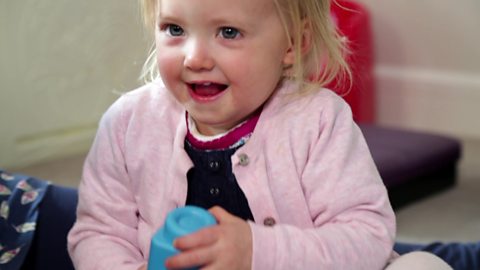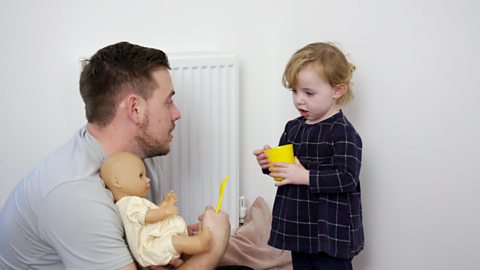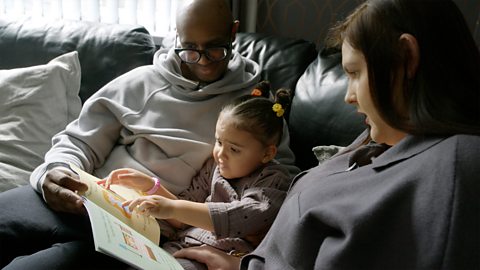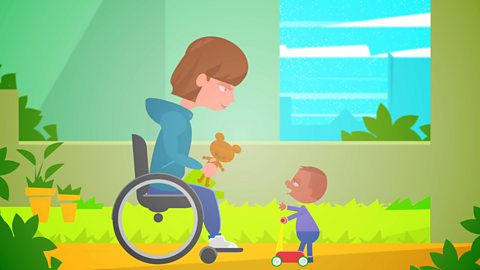When you’re looking after a toddler, chances are you’ve seen them do the same activity over and over again or been asked to tell them their favourite bedtime story repeatedly.
But have you ever stopped to think about why they love repetition and what it does for their learning?
Why is repetition so important to learning?

‚ÄúAs children navigate their way through the world, they're learning about cause and effect all the time‚ÄĚ says Dr Michelle Peter, a children‚Äôs language researcher and social scientist. ‚ÄúIt's the concept that they need to understand that their actions and behaviours have an effect on the people around them and the objects around them.‚ÄĚ
This can be demonstrated clearly through activities like playing with building blocks: when a child stacks too many blocks, the tower falls over. When they do this over and over and see this happen repeatedly, they learn that, as a rule, big towers are likely to fall. Child psychologist Dr Linda Blair says that repetition helps them cement the idea that certain actions lead to certain events happening. ‚ÄúIf you can imagine being a child, absolutely everything is new and unconnected to everything else.‚ÄĚ
Through repetition, particularly repeating sequences, they begin to make sense of what’s going on all around them. It's no longer random.

Repeating language alongside these repeated actions can help babies and toddlers make sense of words too. ‚ÄúSo instead of just knowing the words ‚ÄėDaddy‚Äô and ‚Äėbye-bye‚Äô, they learn that when Daddy puts his hat on and they hear ‚ÄėDaddy, bye-bye‚Äô, Daddy is heading out,‚ÄĚ says Linda.
The understanding they form from this repetition comes in handy when they hear words used in different contexts too. ‚ÄúWhen they hear ‚ÄėMummy bye-bye‚Äô, they‚Äôre starting to be able to make predictions about the world‚ÄĚ she says. Having seen ‚Äėbye-bye‚Äô used in relation to Daddy so many times means they‚Äôre able to predict what Mummy is doing when she says ‚Äėbye-bye‚Äô too.
We often hear how children start making predictions about language as their understanding develops and they start making best guesses, Linda notes. ‚ÄúChildren will say things like ‚ÄėI go-ed to the store‚Äô. Now, nobody said that to them, but they‚Äôve figured out, without being aware of it, that if you add ‚Äėed‚Äô to an action word, it means the action has already taken place.‚Äô
Dr Michelle Peter talks to parents about how their children learn through playing with building blocks
Michelle:
Was it you?
As children are navigating their way through the world, they're learning about cause and effect all the time.
It's the concept that they need to understand that their actions and their behaviours have an effect on the people around them, on the objects around them.
And there are some things that we can do to encourage their understanding of that.
One thing that we're going to do today, is to build a tower and we're gonna knock them down!
Shall we build a tower? Shall we? Look, shall I start?
That's it, well done. Look at that.
Most toddlers like to do things over and over and over again. So building it up, knocking it down, building it up, and knocking it down.
That repetition really helps to embed their understanding of the concept.
Mum:
Oh, it's wobbling.
Michelle:
Developing their understanding of the fact that you know, that their actions have effects on the world, can help with their other skills as well.
So the ability to make predictions about the world, the ability to problem solve.
Mum 2:
What happens? Uh oh!
Why do children like to do the same things repeatedly during play?

It‚Äôs the ability to predict that drives children to repeat actions over and over, says Linda. ‚ÄúThe cortex at the front of our brain is all about planning and prediction and knowing what's going to come.‚ÄĚ
Repetition reinforces chunks of memory so we can predict the future. And when you can predict things you get dopamine, a powerful reward hormone released in the brain.
‚ÄúSo children do things over and over again until it's really clear to them what's going to happen. It makes them laugh ‚Äď they laugh when the tower falls down the second and third time, and that's because they‚Äôre getting this hit of reward in their brain.‚ÄĚ
This is really convenient for their learning, because they are rewarded with brain chemicals for doing the things that help them learn. This means they are more and more likely to keep repeating actions and learning without the need for prompting, says Linda.
‚ÄúAs parents, you don't have to worry about whether the child's going to do things over and over again. You don't have to make them do it - they'll want to do it!‚ÄĚ And the more they do the same things and see the same results, the less they have to think about what is happening. ‚ÄúIt makes their memory more efficient over time because they chunk together these chains of causation. They don't have to break it apart every time and think, ‚Äėoh yeah, this happens and then this.‚Äô‚ÄĚ

How can you encourage children to move beyond repeating what they already know?

To progress your child’s learning, Linda says it’s worth challenging them to build on what they know already.
‚ÄúSay that your little child keeps stacking 3 blocks, but no more, so they never learn about instability and things falling down. To challenge that child, you could put 3 blocks up in front of them and then hand them another block so that they're likely to put the fourth block on. This way you‚Äôre meeting them at their level but inviting them to move to the next level. When they do place that next block on and the tower falls, enjoy the reward with them by clapping and laughing.‚ÄĚ
This same idea can apply to language too. A key way of helping children who can say single words or short phrases is to repeat it back to them and add an additional word or two to demonstrate how what they say can be built into longer phrases.
This is encouraged by speech and language therapist Janet Cooper. ‚ÄúOne of the best techniques is to start to add a word. So if the child says ‚Äėbear‚Äô, you say ‚Äėyes, teddy bear‚Äô. And that puts that word into context for the child, so they start to learn how those early sentences are built up. Don't correct them, just add a little bit more.‚ÄĚ The more they hear you saying longer phrases, the more likely they will be to begin using longer phrases themselves.

Why do children like to hear the same story over and over?
It’s not just repeated actions and behaviours that children learn from. Chances are if you are parent to a toddler, you’ve had to read the same favourite story repeatedly. Once more, it’s the predictability that they love.
‚ÄúThey know what to expect, and so they get their reward.‚ÄĚ But it‚Äôs not just the dopamine hit ‚Äď they feel more in control because they're not going to be surprised or scared. And when children are safe in the knowledge of what is coming in the story, it helps their language learning. ‚ÄúThey can pay attention to the vocabulary better,‚ÄĚ says Linda.
A study by the University of West Sussex found this to be the case. When children heard the same story repeated over and over, children’s recall of new vocabulary was found to be much better than when they were read a variety of different stories.
An animation all about how children learn through stories being repeated
Not the same story again!? Does your toddler like to hear the same story over and over and over? Well, the good news? It actually helps them learn new words. Between two and three years old, your child won’t be able to read yet themselves, but sharing a storybook is still fantastic for their language learning. It’s a great opportunity to hear the names of things they don’t see in real life, like dinosaurs, dragons and whatever this guy is!
You don‚Äôt have to be a brilliant reader. In fact, you don‚Äôt need to read at all to share a book ‚Äď sharing a story can just mean talking to your child about the pictures on the page. It still really helps their language learning. And yes, being asked to share the same story over and over can be a tiny bit boring but here, science is on your child‚Äôs side!
In a study of two-year-olds, researchers tried teaching them new words from storybooks. Half the children heard the new words, repeated in three separate stories.And half the children heard the new words in one story, but read to them three times. Amazingly, only toddlers who had heard the same story repeatedly remembered the new words. So, if it gets a bit boring reading that same story over and over, just remember you’re helping support their language learning! Ask lots of questions about the pictures in the book. Ask them what the characters are doing and talk about whatever pictures on the page take their interest. They’ll love it!
Keeping story time fun

There are plenty of ways to make retelling stories more rewarding for you:
Put on voices
‚ÄúIf you‚Äôre comfortable trying new voices, match the characters where you can. Bring in a big, loud voice if a character is a giant, or a tiny, squeaky voice for a mouse,‚ÄĚ says Janet. Not only will it bring a story to life, but the increased interest children take can help them understand the words.
‚ÄúNot everybody is comfortable being animated, but the more you can put ‚Äėup and down‚Äô into your voice, the better,‚ÄĚ said Janet. ‚ÄúIf you go a little flat or monotone, you will find a child‚Äôs interest will wander off.‚ÄĚ
Try changing the words a little
‚ÄúWhen they are familiar with the story, you can change the words to see if they spot it. That‚Äôs great for their listening skills,‚ÄĚ says Janet. Linda concurs: ‚ÄúFor example, you could change ‚Äėthey ran all the way home‚Äô to ‚Äėthey skipped all the way home‚Äô. It‚Äôll make them laugh and teaches them new vocabulary.‚ÄĚ You could even add sound effects to your story.

Make it interactive
You could ask your child for their input on how the story could be changed. ‚ÄúYou could read it and then at the end say ‚Äėis there another ending? Could we have mice instead of piggies?‚Äô‚ÄĚ suggests Linda.
You could test their older children’s memories by asking them about the story and seeing what they can retell. Asking about what happened in a book can help your child talk about the past.
You could also ask them questions beyond the story, for example, how they would feel if something that happened in the story had happened to them. This is really useful, because it encourages them to look at things from another point of view. When they can do that, they’ll start to understand why people can have different reactions to the same event.
Share the joy
If you know how much your child is learning through repetition, you can share their joy as you tell a story for what seems like the hundredth time. ‚ÄúJust look at your child, because the joy on their face is reward for any parent,‚ÄĚ says Linda.






